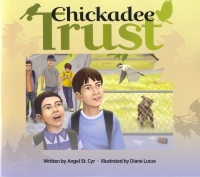| ________________
CM . . .
. Volume XVIII Number 21. . . .February 3, 2012 
 |
Chickadee Trust.
Angel St. Cyr. Illustrated by Diane Lucas.
Winnipeg, MB: Pemmican Publications, 2011.
48 pp., stapled, $10.95.
ISBN 978-1-894717-67-0.
Subject Heading:
Métis-Juvenile fiction.
Grades 1-5 / Ages 6-10.
Review by Todd Kyle.
** /4
|
| |
|

excerpt:
My Mom was pretty cool. She could tell you anything you wanted to know about plants, trees, animals, and birds. She could even call the chickadees, and they would come to her and eat out of her hands. I was watching her feed the birds, and the little boy who lived next door was also watching her. She filled the feeders and then stood on the second-floor deck of our house and started calling: "Chick a dee dee, Chick a dee, Chick a dee dee." We could hear the little birds answering her. She smiled and held out a handful of sunflower seeds and called again: "Chick a dee dee." Suddenly, there were these little birds in the trees, and some started flying around her, landing on the railings and the back of the chairs.
In a flash of brown and white there was one in her hand, and then another followed. They kept on coming and she laughed. I guess their feet tickled her hand. The laughter seemed to make them nervous and they stopped coming close to her, so she emptied the seeds out of her hand.
I heard Zachary, the boy next door, say, "Wow! Are you magic or something?"
An unnamed 12-year-old Métis boy living in a poor urban neighbourhood gradually loses trust in his peers as they bully him and his brother and steal from and vandalize his home. He looks forward to moving to a better, more rural neighbourhood with his mother and stepfather, but when they finally do, he does not trust people enough to make new friends. His mother takes him on a walk in the woods where she passes on her expertise at getting chickadees to trust her enough to eat from her hand, passing on a lesson to her son about the need to be patient and trust people. The boy is able to make friends as he begins at his new school.
It is welcome to see the Métis presented in a picture book in a modern context and with contemporary fears and joys, illuminated by a closeness to nature connected to their heritage but not explicitly so. The narrator effectively evokes empathy for his own situation and conveys his adolescent feelings for the obviously poorer kids who bully him—sympathy, but limited. The mother's way with the chickadees, and the touching lesson they inspire, is compelling and a story worth telling.
 But there is an unevenness to the story and the way that it is told that makes it seem less than satisfying. The chickadees are first introduced halfway through the story, in an episode that is unconnected to those that precede and follow it, and concluded with the boy's assertion that he doesn't understand his mother's lesson but that "eventually I would." It is hard not to think that the chickadee motif should have been where the story began (as it is, it begins with the family packing to move). It is also hard to understand why the main character is never named, nor even the most significant of the bullies. In fact, the narrator names only his brother Austin and the fairly insignificant character Zachary (who, as in the excerpt above, is named in the second reference to him). It is also disappointing that there is no explanation for his assertion that he is bullied because "I am Métis, but not as dark-skinned as some of the other kids." Are these other kids also Métis, or are they full Native? Some readers might also wonder about the stepfather, who, with a trim grey beard, might be European—or not.
But there is an unevenness to the story and the way that it is told that makes it seem less than satisfying. The chickadees are first introduced halfway through the story, in an episode that is unconnected to those that precede and follow it, and concluded with the boy's assertion that he doesn't understand his mother's lesson but that "eventually I would." It is hard not to think that the chickadee motif should have been where the story began (as it is, it begins with the family packing to move). It is also hard to understand why the main character is never named, nor even the most significant of the bullies. In fact, the narrator names only his brother Austin and the fairly insignificant character Zachary (who, as in the excerpt above, is named in the second reference to him). It is also disappointing that there is no explanation for his assertion that he is bullied because "I am Métis, but not as dark-skinned as some of the other kids." Are these other kids also Métis, or are they full Native? Some readers might also wonder about the stepfather, who, with a trim grey beard, might be European—or not.
The illustrations, although uneven, are evocative at their best, at times presenting the main character with more humanity and warmth than the story, itself. The sideways glances on the faces of bullies evoke very well the unease of the old neighbourhood, the chickadees themselves (one appears on each page) are compelling, and the boy is both recognizable and distinctive at each of the younger ages at which he is depicted.
Overall, the Métis content adds value to what would otherwise be a slightly awkward and unremarkable story about peer relations.
Recommended with reservations.
Todd Kyle is the CEO of the Newmarket Public Library in Newmarket, ON.

To comment
on this title or this review, send mail to cm@umanitoba.ca.
Copyright © the Manitoba Library Association. Reproduction for personal
use is permitted only if this copyright notice is maintained. Any
other reproduction is prohibited without permission.
NEXT REVIEW |
TABLE OF CONTENTS FOR THIS ISSUE
- February 3, 2012.
AUTHORS |
TITLES |
MEDIA REVIEWS |
PROFILES |
BACK ISSUES |
SEARCH |
CMARCHIVE |
HOME |

 But there is an unevenness to the story and the way that it is told that makes it seem less than satisfying. The chickadees are first introduced halfway through the story, in an episode that is unconnected to those that precede and follow it, and concluded with the boy's assertion that he doesn't understand his mother's lesson but that "eventually I would." It is hard not to think that the chickadee motif should have been where the story began (as it is, it begins with the family packing to move). It is also hard to understand why the main character is never named, nor even the most significant of the bullies. In fact, the narrator names only his brother Austin and the fairly insignificant character Zachary (who, as in the excerpt above, is named in the second reference to him). It is also disappointing that there is no explanation for his assertion that he is bullied because "I am Métis, but not as dark-skinned as some of the other kids." Are these other kids also Métis, or are they full Native? Some readers might also wonder about the stepfather, who, with a trim grey beard, might be European—or not.
But there is an unevenness to the story and the way that it is told that makes it seem less than satisfying. The chickadees are first introduced halfway through the story, in an episode that is unconnected to those that precede and follow it, and concluded with the boy's assertion that he doesn't understand his mother's lesson but that "eventually I would." It is hard not to think that the chickadee motif should have been where the story began (as it is, it begins with the family packing to move). It is also hard to understand why the main character is never named, nor even the most significant of the bullies. In fact, the narrator names only his brother Austin and the fairly insignificant character Zachary (who, as in the excerpt above, is named in the second reference to him). It is also disappointing that there is no explanation for his assertion that he is bullied because "I am Métis, but not as dark-skinned as some of the other kids." Are these other kids also Métis, or are they full Native? Some readers might also wonder about the stepfather, who, with a trim grey beard, might be European—or not.